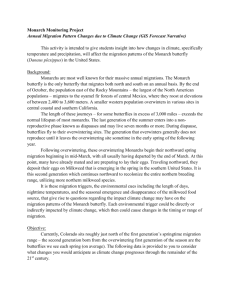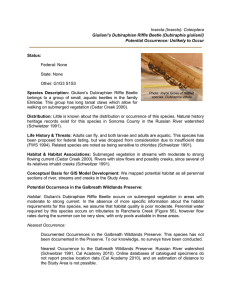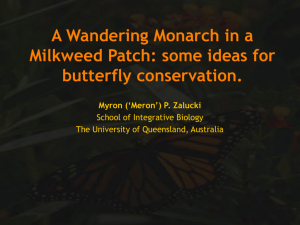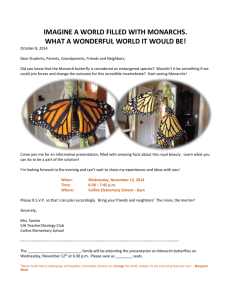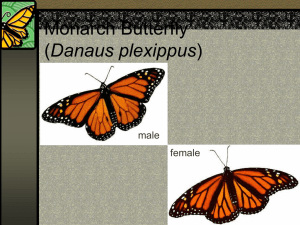DAPL Text
advertisement
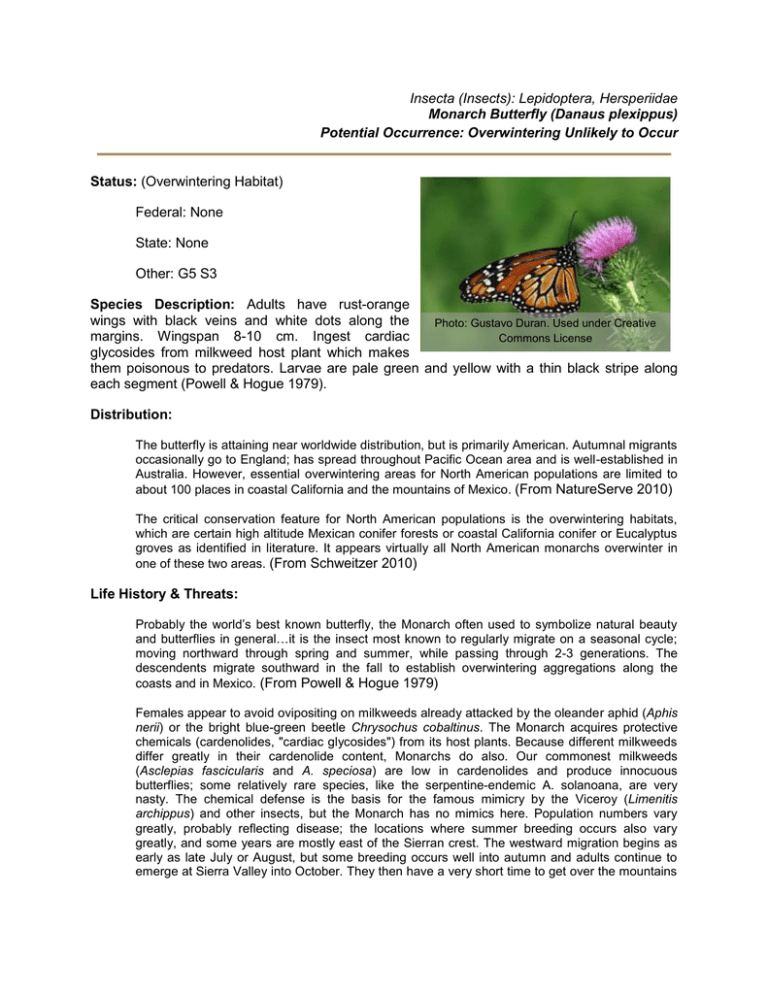
Insecta (Insects): Lepidoptera, Hersperiidae Monarch Butterfly (Danaus plexippus) Potential Occurrence: Overwintering Unlikely to Occur Status: (Overwintering Habitat) Federal: None State: None Other: G5 S3 Species Description: Adults have rust-orange wings with black veins and white dots along the Photo: Gustavo Duran. Used under Creative margins. Wingspan 8-10 cm. Ingest cardiac Commons License glycosides from milkweed host plant which makes them poisonous to predators. Larvae are pale green and yellow with a thin black stripe along each segment (Powell & Hogue 1979). Distribution: The butterfly is attaining near worldwide distribution, but is primarily American. Autumnal migrants occasionally go to England; has spread throughout Pacific Ocean area and is well-established in Australia. However, essential overwintering areas for North American populations are limited to about 100 places in coastal California and the mountains of Mexico. (From NatureServe 2010) The critical conservation feature for North American populations is the overwintering habitats, which are certain high altitude Mexican conifer forests or coastal California conifer or Eucalyptus groves as identified in literature. It appears virtually all North American monarchs overwinter in one of these two areas. (From Schweitzer 2010) Life History & Threats: Probably the world’s best known butterfly, the Monarch often used to symbolize natural beauty and butterflies in general…it is the insect most known to regularly migrate on a seasonal cycle; moving northward through spring and summer, while passing through 2-3 generations. The descendents migrate southward in the fall to establish overwintering aggregations along the coasts and in Mexico. (From Powell & Hogue 1979) Females appear to avoid ovipositing on milkweeds already attacked by the oleander aphid (Aphis nerii) or the bright blue-green beetle Chrysochus cobaltinus. The Monarch acquires protective chemicals (cardenolides, "cardiac glycosides") from its host plants. Because different milkweeds differ greatly in their cardenolide content, Monarchs do also. Our commonest milkweeds (Asclepias fascicularis and A. speciosa) are low in cardenolides and produce innocuous butterflies; some relatively rare species, like the serpentine-endemic A. solanoana, are very nasty. The chemical defense is the basis for the famous mimicry by the Viceroy (Limenitis archippus) and other insects, but the Monarch has no mimics here. Population numbers vary greatly, probably reflecting disease; the locations where summer breeding occurs also vary greatly, and some years are mostly east of the Sierran crest. The westward migration begins as early as late July or August, but some breeding occurs well into autumn and adults continue to emerge at Sierra Valley into October. They then have a very short time to get over the mountains before the weather turns hostile. Altogether, there are three to four generations in an average year, but the mobility of the butterflies makes it difficult to pin this down. (From Shapiro 2010) The monarch’s NatureServe Global status is G5, meaning that is considered secure globally. The threats faced by the monarch are most pressing in its overwintering grounds, where development and deforestation can interfere with populations’ survival (Schweitzer 2010). Habitat & Habitat Associations: Overwintering Habitat: The critical conservation feature for North American populations is the overwintering habitats, which are certain high altitude Mexican conifer forests or coastal California conifer or Eucalyptus groves as identified in literature. It appears virtually all North American monarchs overwinter in one of these two areas. (From Schweitzer 2010) Breeding Habitat: Individuals may be found all over the state, but breeding takes place at mid to low elevations. (Schweitzer 2010) In general breeding areas are virtually all patches of milkweed in North America and some other regions. (From Schweitzer 2010) Species of milkweed that are known to occur in Mendocino County that could be larval host plants to the Monarch are Asclepias californica ssp. greenei, A. cordifolia, A. eriocarpa, A. fascicularis, and A. speciosa (CalFlora 2010; Smith 1992). A milkweed species that is widely used by Monarchs in foothills and mountains is the purple milkweed, A.cordifolia (Shapiro 2010). Feeding Habitat: Adult monarchs are not limited to feeding on milkweed and, due to their long proboscis, will feed from many types of flowers which have a long corolla. (From Shapiro 2010) Conceptual Basis for GIS Model Development: Potential overwintering habitat was mapped as coniferous forest vegetation types. Potential Occurrence in the Galbreath Wildlands Preserve: Protection status for this species applies to overwintering habitat. Habitat: Conifers needed by Monarchs as overwintering habitat are abundant in the Preserve. Nearest Occurrence: Documented Occurrences in the Galbreath Wildlands Preserve: This species has not been documented on the Preserve. To our knowledge no surveys have been conducted. Nearest Occurrence to the Galbreath Wildlands Preserve: Overwintering sites in California are limited to about 100 locations (NatureServe 2010). This species has been reported to occur in the Stewarts Point USGS quad southwest of the Preserve. Summary: Overwintering colonies of Monarch butterflies are “Unlikely to Occur” in the Preserve because colonies are rare along the California coast, and coniferous habitat is abundant in areas surrounding the Preserve. References Calflora 2010. Information on California plants for education, research and conservation, based on data contributed by the Consortium of Calif. Herbaria and dozens of other public and private institutions and individuals. [web application]. 2010. Berkeley, California: The Calflora Database [a non-profit organization]. <http://www.calflora.org/>. Accessed 2010 Jun 24 Hickman, JC. 1993. The Jepson Manual: Higher Plants of California. Berkeley: University of California Press. p. 170-171 Powell, JA and CL Hogue. 1979. California Insects. Berkeley: University of California Press. p 246-248 NatureServe. 2010. Schweitzer, D. 2010 Feb 2. Comprehensive Report Species- Danaus plexippus. NatureServe Explorer: An online encyclopedia of life [web application]. Version 7.1. NatureServe, Arlington, Virginia. <http://www.natureserve.org/explorer> (Accessed: June 23 6, 2010). Shapiro, AM. Art Shapiro’s Butterfly Site: Danaus plexippus. <http://butterfly.ucdavis.edu/butterfly/Danaus/plexippus>. Accessed 2010 Jun 24. Smith GL, Wheeler CR. 1992. A flora of the Vascular Plants of Mendocino County, California. San Francisco: University of San Francisco. p. 271-2. Species Account Description: Kandis Gilmore & Emily Harvey
